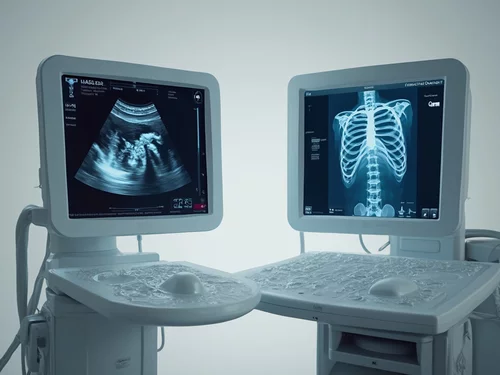Choosing the right imaging technique can feel daunting, especially when the stakes involve your health. Understanding the distinctions between ultrasound and X-ray imaging can empower you to make informed healthcare decisions that suit your needs.
What You Will Learn
- Ultrasound imaging is a safe, non-invasive method using sound waves, with no radiation exposure.
- X-ray imaging utilizes ionizing radiation to visualize hard tissues, making it effective for diagnosing bone-related issues.
- Safety considerations differ, as ultrasound is safe for all patients, including pregnant women, while X-rays carry potential radiation risks.
- Understanding your specific condition can guide you in selecting between ultrasound and X-ray based on imaging needs.
- Asking the right questions when discussing imaging options with healthcare professionals enhances your understanding and involvement in your healthcare journey.
Ultrasound vs. X-Ray: A Comparative Overview
This visual outlines the key distinctions between Ultrasound and X-Ray imaging technologies, highlighting their fundamental differences and typical applications.
Ultrasound Imaging
Uses high-frequency sound waves to create real-time images of the body's internal structures.
- ✓ Non-invasive, no radiation
- ✓ Safe for pregnancy & frequent use
- ✓ Best for soft tissues, blood flow, fetal monitoring
X-Ray Imaging
Utilizes ionizing radiation to produce static images, primarily of dense structures.
- ✗ Involves ionizing radiation
- ✗ Limited use in pregnancy
- ✓ Ideal for bones, fractures, foreign objects
Understanding the Basics: Ultrasound and X-Ray Imaging
When it comes to understanding diagnostic imaging, two key players often come to mind: ultrasound and X-ray. Both are invaluable tools in the medical field, yet they operate on different principles and serve distinct purposes in patient care. Let’s dive into what each of these imaging techniques entails, helping you to feel more informed and empowered about your healthcare decisions.
At Reservoir Healthcare Guide, we believe that knowledge is the first step toward effective health management. Understanding the basics of these imaging modalities can significantly impact your treatment journey!
What is Ultrasound Imaging?
Ultrasound imaging, also known as sonography, utilizes high-frequency sound waves to create images of the inside of your body. The process is safe, non-invasive, and does not involve any radiation. Instead, it captures the echoes of sound waves as they bounce off tissues, forming a visual representation that doctors can analyze. For a deeper understanding of its applications, you can read more about a comparison study on ultrasound in children with lower respiratory tract infections.
- Commonly used during pregnancy to monitor fetal development
- Useful for examining organs, tissues, and blood flow
- Often employed in guiding biopsies and evaluating conditions like gallstones
Ultrasound is particularly favored for its real-time imaging capabilities, making it a preferred choice for assessing moving structures, such as the heart and blood vessels.
What is X-Ray Imaging?
X-ray imaging, on the other hand, employs ionizing radiation to produce images of the body’s internal structures. This technique is especially effective for visualizing hard tissues, such as bones. An X-ray machine sends a small dose of radiation through the body, capturing images that highlight areas of concern. You can find more information on chest X-rays in children in this comparative study.
- Primarily used to diagnose fractures and bone diseases
- Helpful in detecting infections, tumors, and foreign objects
- Commonly utilized in dental assessments and chest exams
With its ability to penetrate soft tissues but not dense structures like bones, X-ray imaging provides crucial insights in various medical settings, reinforcing its role as a staple in diagnostics.
Key Differences Between Ultrasound and X-Ray
Understanding the differences between ultrasound and X-ray imaging can guide your decision when seeking diagnostic tests. Each modality has its strengths and specific applications, so let’s break it down further!
Technology Explained: Sound Waves vs. Ionizing Radiation
The primary distinction between ultrasound and X-ray lies in the technology they use. As mentioned, ultrasound utilizes sound waves, while X-ray imaging relies on ionizing radiation. This fundamental difference leads to various applications and considerations in terms of safety and effectiveness.
- Ultrasound is safe for patients of all ages, including pregnant women.
- X-rays can expose patients to radiation, raising concerns in certain situations.
- Ultrasound provides real-time imaging, while X-rays are generally static images.
These differences make each method uniquely suited for specific diagnostic purposes. Understanding these factors is essential for making an informed choice regarding your imaging options.
Safety Considerations: Which Option is Safer for You?
When considering your health, safety is paramount! Both ultrasound and X-ray imaging have their pros and cons, particularly regarding safety. Let’s explore these considerations further.
Radiation Exposure and Its Impact
Radiation exposure is a significant factor when it comes to X-ray imaging. While the doses used in modern X-rays are quite low and considered safe for most adults, it’s vital to assess individual risk factors. This is especially true for frequent imaging or in younger patients whose bodies are still developing. For more details on the safety of diagnostic imaging and patient radiation dose, refer to this resource on diagnostic radiology safety.
Pregnancy and Ultrasound: A Safer Choice?
For expectant mothers, ultrasound imaging is often the go-to choice. Since it does not use ionizing radiation, it is deemed safe for monitoring fetal development. In fact, regular ultrasounds can provide valuable insights into the health and growth of the baby, making it a cornerstone of prenatal care!
Having a clear understanding of these imaging techniques can help you navigate your healthcare journey with confidence. If you have any questions or concerns about ultrasound or X-ray imaging, feel free to reach out! At Reservoir Healthcare Guide, we’re here to support you every step of the way.
We Want to Hear From You!
When it comes to choosing between ultrasound and X-ray imaging, what factors are most important to you? Share your thoughts below:
Making an Informed Decision: Ultrasound vs. X-Ray
Choosing between ultrasound and X-ray imaging can feel overwhelming. With various factors to consider, it’s essential to weigh your options carefully. I often remind patients that understanding your healthcare choices empowers you to make informed decisions that suit your unique needs!
Here are some key factors to keep in mind:
- Type of Condition: Consider whether you need to examine soft tissues or bones.
- Patient Safety: Think about the safety aspect, especially if you’re pregnant or have concerns about radiation.
- Cost: Understand the potential costs associated with each imaging type.
- Technological Availability: Check what your local facility offers and which method they specialize in.
These points can guide you in selecting the best imaging option for your situation. I always encourage patients to ask questions—don’t hesitate to reach out for clarity!
Consulting with Healthcare Professionals: What to Ask
When discussing your imaging options with healthcare professionals, come prepared with questions that help you understand the process better. Here are some essential inquiries you should consider:
- What type of imaging do you recommend for my condition?
- Can you explain the differences between an ultrasound and an X-ray in my specific case?
- What are the potential risks associated with each imaging option?
- How should I prepare for the imaging test?
Having these questions ready not only shows your engagement but also allows for a more productive conversation. Remember, it’s your health journey, and understanding all elements is crucial!
Your Next Steps: Scheduling Your Imaging Appointment
Once you've gathered all necessary information and made an informed decision, the next step is to schedule your imaging appointment. This can often feel like another task on your to-do list, but with a little preparation, you can make the process smoother.
Finding a Reliable Imaging Clinic
Finding a trustworthy imaging clinic is vital for your experience. Here are some tips for selecting the right one:
- Research Local Options: Look for clinics in the Reservoir area that specialize in the imaging type you need.
- Read Reviews: Check patient reviews to assess the quality of care provided.
- Consult Your Doctor: Ask your healthcare provider for recommendations on where to go.
Being proactive in your search can lead to a better overall experience for you and your family!
Preparing for Your Visit: Tips for a Smooth Experience
Preparation is critical for a successful imaging appointment. Here’s how to ensure everything goes off without a hitch:
- Wear comfortable clothing, ideally without zippers or metal components.
- Follow pre-appointment instructions, like fasting or hydration, if needed.
- Arrive early to complete any necessary paperwork.
Taking these steps can help alleviate stress, allowing you to focus on what truly matters—getting the right care!
Understanding Patient Education and Imaging Protocols
Finally, understanding patient education and protocols surrounding imaging can significantly enhance your experience. Ask your healthcare provider about:
- What information will be shared with you post-imaging?
- How long it usually takes to receive results?
- What follow-up steps you may need to take after your appointment.
Remember, knowledge is power. At Reservoir Healthcare Guide, we are committed to helping you navigate your healthcare decisions confidently! If you have any questions or need further guidance, feel free to reach out—we’re here to help you every step of the way!
Frequently Asked Questions (FAQs)
What is the main difference between ultrasound and X-ray imaging?
The main difference lies in the technology used: ultrasound employs high-frequency sound waves and is non-invasive with no radiation, while X-ray imaging uses ionizing radiation to visualize dense structures like bones.
Is ultrasound imaging safe for pregnant women?
Yes, ultrasound imaging is considered safe for pregnant women because it does not use ionizing radiation and is a preferred method for monitoring fetal development.
What are X-rays primarily used for?
X-rays are primarily used to diagnose fractures, bone diseases, and to detect infections, tumors, and foreign objects, especially in hard tissues.
What are the safety concerns associated with X-ray imaging?
X-ray imaging involves exposure to ionizing radiation. While modern X-rays use low doses, it's important to consider individual risk factors, especially for frequent imaging or in younger patients.
What factors should I consider when choosing between ultrasound and X-ray?
When choosing, consider the type of condition (soft tissue vs. bone), patient safety (especially for pregnancy or radiation concerns), cost, and technological availability at local facilities.
Recap of Key Points
Here is a quick recap of the important points discussed in the article:
- Ultrasound imaging uses sound waves and is safe for all ages, including pregnant women.
- X-ray imaging employs ionizing radiation and is primarily used for diagnosing fractures and visualizing hard tissues.
- Understanding the differences between ultrasound and X-ray helps in making informed healthcare decisions.
- Safety considerations are crucial; ultrasound is generally safer, while X-rays require assessment of individual risk factors.
- When choosing an imaging option, consider the type of condition, patient safety, cost, and technological availability.
- Prepare questions for healthcare professionals to facilitate better understanding of your imaging choices.
- Research and find a reliable imaging clinic to ensure a smooth experience.










